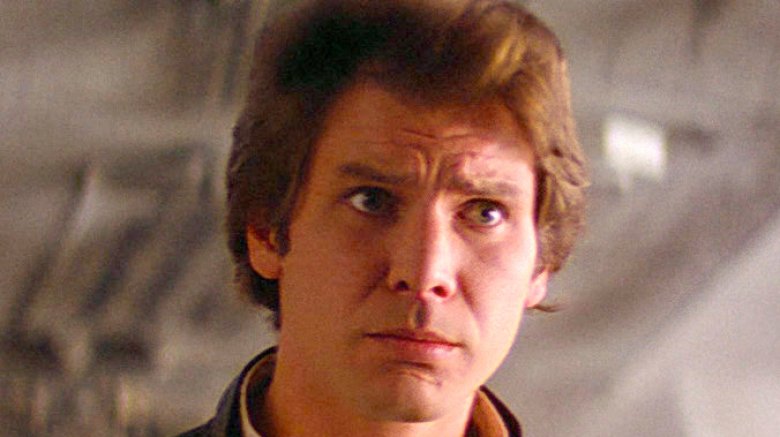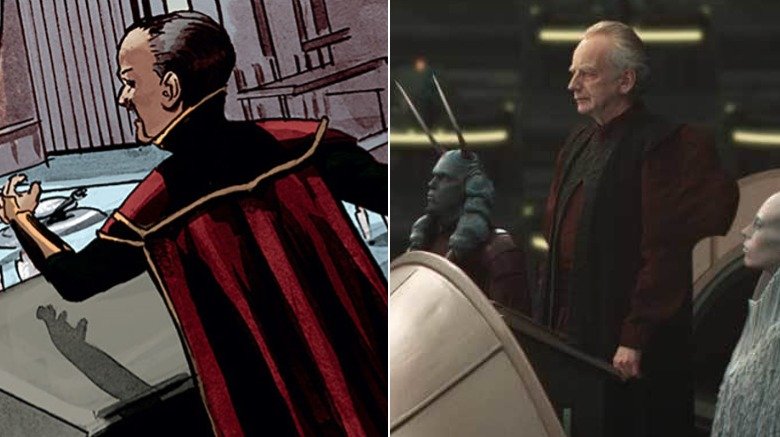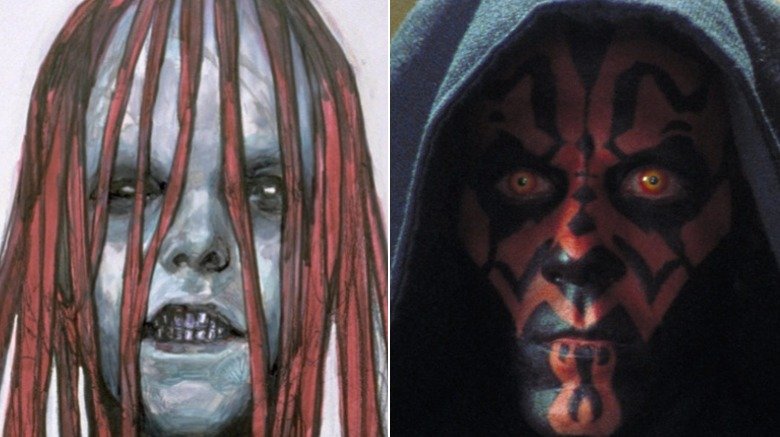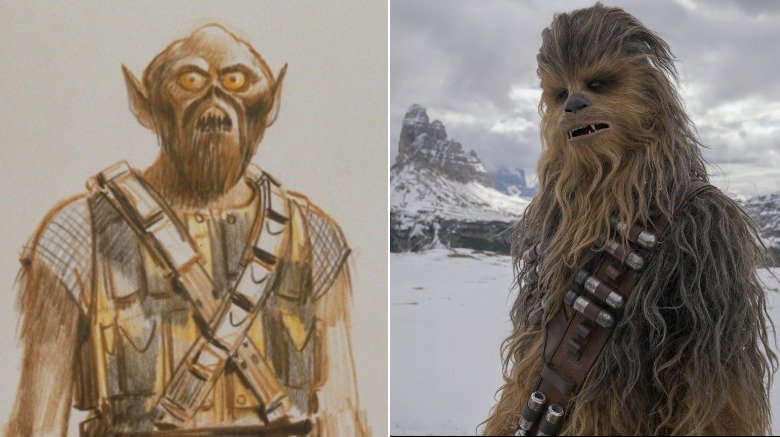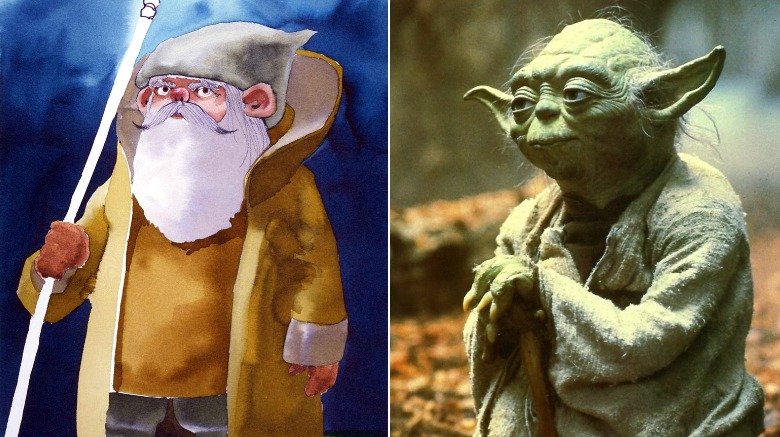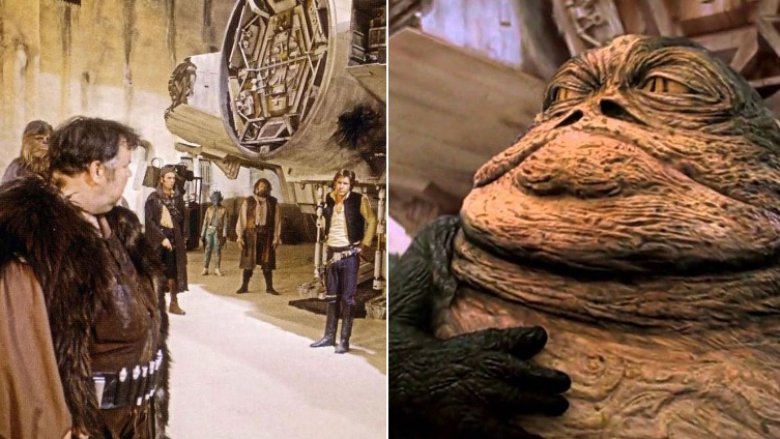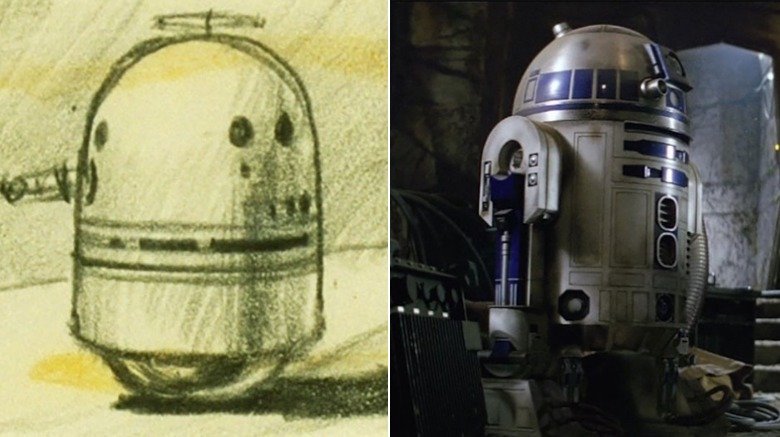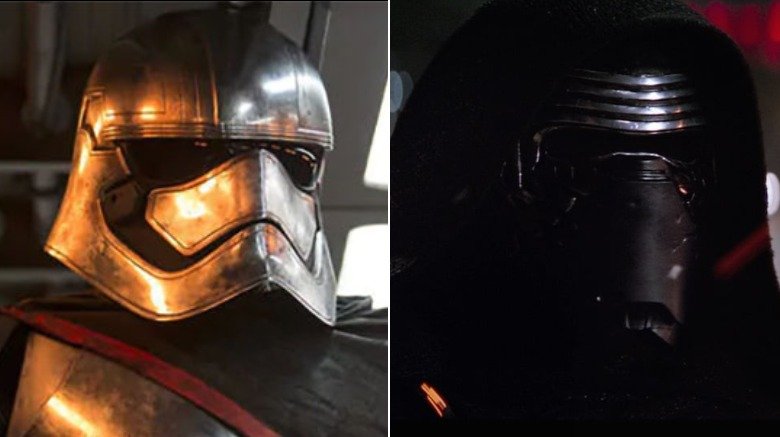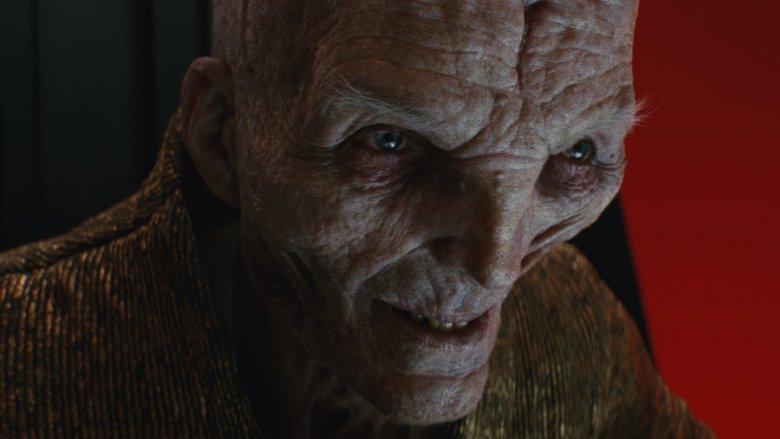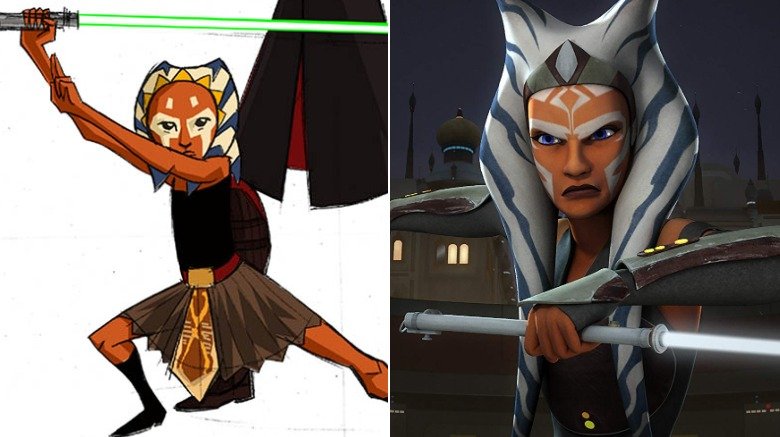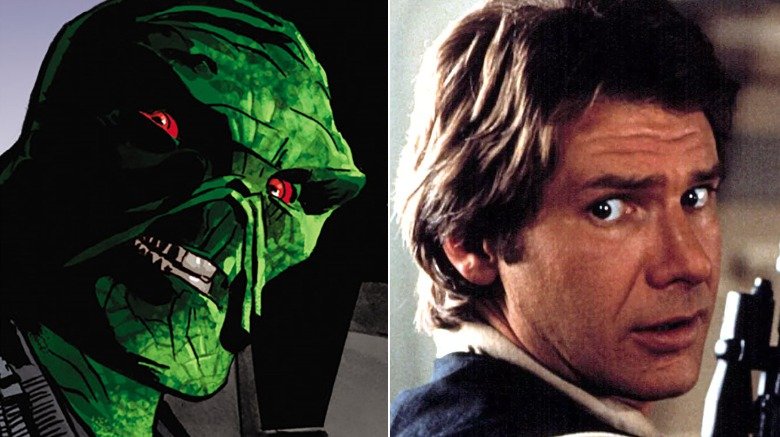These Star Wars Characters Almost Looked Totally Different
Here's the dirty little secret about Star Wars: George Lucas made the whole thing up as he went along. While Lucas has claimed that his entire six-film saga (or nine films, or twelve — see what we mean?) followed a set outline from the very beginning, and while there are some themes and ideas that have survived from Lucas' first drafts, Star Wars' history is full of compromises, contradictions, and changing plans. That's a tradition that Disney is upholding, too. Until it's actually onscreen, nothing in a galaxy far, far away is set in stone.
That includes its characters. While the Star Wars series contains many of the most iconic character designs in cinematic history — you don't have to be a Star Wars superfan to recognize Darth Vader, Yoda, Chewbacca, or the stormtroopers — they didn't arrive fully realized. Some changed alongside the scripts. Others went through a lengthy pre-production process before arriving at their final forms, and a few early designs even survived as totally different characters. A lot of the original Star Wars concepts look extremely cool, too. We're glad we got the Star Wars that we did, but it's still fun to see what could've been. Go ahead. Take a look.
Emperor Palpatine
Emperor Palpatine, head of the evil Galactic Empire, first burst onto the scene as a floating hologram with wrinkled skin and monkey eyes, and later became synonymous with actor Ian McDiarmid, who played him in Return of the Jedi and the prequel movies, often wearing prosthetics and sporting chalky white skin. In George Lucas' earliest Star Wars script, however, the Emperor was incredibly different — not just in looks, but in personality, too.
Lucas described Emperor Cos Dashit as "a thin, grey looking man, with an evil mustache which hangs limply over his insipid lip," and he has the personality to match. Dashit only appears once in the screenplay, and he's not a particularly imposing or powerful figure. Instead of the man running the show, Dashit is an easily manipulated politician who's little more than a puppet for the bureaucrats who surround him.
That characterization held even after Dashit became Palpatine, and even worked its way into some sort-of canon material. According to Alan Dean Foster's official Star Wars novelization, Palpatine retreated from public life shortly after assuming power. In his absence, other politicians "used the Imperial forces and the name of the increasingly isolated Emperor to further their own personal ambitions." It wasn't until the Empire struck back in Episode V that we got the ruthless, calculating Sith lord that we love to hate today — and thank goodness for it.
Darth Maul
Darth Maul is only in Star Wars: Episode I — The Phantom Menace for a couple of minutes, but he's still the highlight of the movie, thanks largely to Ray Park's acrobatic performance, Maul's cool-as-heck double-bladed lightsaber, and his striking black-on-red tattoos (his part in the single best lightsaber duel in the Star Wars franchise's history is a big factor, too).
Still, despite how intimidating Maul's final design is, he almost looked even scarier. While designing Palpatine's first apprentice, designer Iain McCaig only had a brief description: "a vision from your worst nightmare." That's exactly what McCaig drew. "At the time I was haunted by a nightmare of a dead-white face with metal teeth pressed against my rain-spattered studio window," McCaig tells Inverse. Unfortunately, that was a little too scary for Lucas, who passed the sketch back to McCaig with new instructions: "Give me your second worst nightmare."
McCaig decided to go for something a little more mythical for his second try, drawing on a bad experience he had with a Bobo the Clown billboard as a child. He based Maul's face on his own, used red and black lines to accent the Dathomir native's underlying musculature, and set Maul on the path to Star Wars superstardom.
Chewbacca
If Chewbacca resembles any Earthly creature, its an ape — actor Peter Mayhew even went to the zoo to study gorillas and monkeys to prepare for the role — but Chewie didn't start out that way. Not only was Chewbacca inspired by George Lucas' dog, Indiana, who often served as the director's co-pilot (and who went on to lend his name to Lucas' other blockbuster franchise), but concept artist Ralph McQuarrie's original designs didn't look like gorillas at all. They looked like lemurs.
That makes some sense. In the original Star Wars script, Lucas described Chewbacca as "a huge, grey bushbaby with fierce baboon-like fang[s]," which stayed more or a less intact through subsequent revisions. Lucas also told McQuarrie that he imagined Chewbacca "like a lemur with fur over his whole body," and McQuarrie's initial sketches faithfully honor that interpretation. In fact, Lemur-bacca is a fixture in almost all of the early Star Wars concept art. His design only changed once Lucas gave McQuarrie a sketch by John Schoenherr, which accompanied a 1975 story by George R. R. Martin — yes, that George R. R. Martin — to use as inspiration.
Ultimately, Chewbacca ended up as a mashup of all kinds of different animals. He's shaped like a gorilla, his face looks like a cat's, his costume is decorated with yak fur, and his voice is made up of bear, walrus, lion, and badger sounds. Thankfully, McQuarrie's original designs live on in the Star Wars universe, too, as the basis for Star Wars Rebels' Zeb.
Yoda
When Luke first arrives on Dagobah, he doesn't recognize Yoda. Why should he? Not only have the two never met, but Luke is looking for an old, wise, and powerful Jedi master like his friend Ben Kenobi. Instead, he finds a tiny green Muppet who talks funny, causes mischief, and acts like a gibbering buffon. No wonder he's confused.
Maybe Luke would've had better luck if Lucas and his team had stuck to Yoda's original designs. Initially, Yoda wasn't going to be tiny. He was going to be a "large alien" who took some cues from the Yaqui "Indian Sorcerer" Don Juan Matus. As such, early Yoda concepts look more like traditional fantasy characters than Star Wars ones, even once the character was shrunk down. In one picture, Yoda looks more like David the Gnome than an alien, and sports "a hipster handlebar mustache." In another, Yoda has greenish skin and his trademark ears, but still wears a wizard's hat and carries a light-up staff. It looks like something from The Lord of the Rings, not Star Wars, which is probably why it was rejected.
Ultimately, makeup artist Stuart Freeborn, who also created Chewbacca and Jabba's costumes, made the ape suits for 2001, and handled Peter Sellers' different looks in Dr. Strangelove, created a sculpture that combined Albert Einstein's face with his own. That's been Yoda's look ever since.
Jabba the Hutt
As George Lucas tells the story, he wanted Jabba the Hutt to be a giant slug all along. But as the Star Wars Special Editions (and the revisions that came when Star Wars was released on DVD) prove, Lucas changes his stories all of the time, and Jabba's origin story is one of them. In fact, observant fans have noticed that Lucas actually changed script excerpts for some of Star Wars' behind-the-scenes publications, making it look like Jabba was a slimy blob earlier than he actually was.
Lucas claims that Jabba's scenes from A New Hope, which were filmed with Irish actor Declan Mulholland playing a human version of the notorious space gangster opposite Harrison Ford, were supposed to feature a stop-motion creature. The evidence indicates otherwise. Mulholland is wearing a full costume that fits right in with the rest of Mos Eisley's ne'er-do-wells. There are no blue screens or other effects-friendly accessories on set, and there are no pre-production sketches of a Jabba-like creature — only designs for Mulholland's outfit.
The real reason why Mulholland's Jabba didn't survive seems to be the result of production problems, not creative ones. The footage of Jabba and Han's meeting was plagued by camera problems, while Han's meeting with Greedo covered a lot of the same ground (including some of the same lines). Lucas said he wasn't happy with how Jabba's henchmen looked, but didn't say anything about Jabba himself. Just imagine: If the cameras had worked properly, Jabba would've looked totally different.
R2-D2
George Lucas had a very specific vision for Star Wars, but when it came to the details, he left a lot of the heavy lifting to his staff. As such, when Ralph McQuarrie had to design R2-D2, he didn't get much guidance. "I think Artoo was just described as a small robot," McQuarrie recalls. "I thought of him as running on a giant ball bearing — just a sphere, a circle, wheel-like. He had gyros so he could go in any direction on this ball."
Sound familiar? It should. The rolling design was ultimately deemed too complicated for '70s technology, and R2-D2's final look ended up resembling a garbage bin more than a soccer ball, but JJ Abrams revived it — and a bunch of other old, discarded Star Wars concepts — when he rebooted the franchise with Star Wars: Episode VII — The Force Awakens. Remember BB-8? Yes, that's right: the sequel trilogy's breakout star is more or less a rehashed R2-D2 concept.
Not that BB-8 was much easier to make in 2015, of course. While Lucasfilm did make a fully-functioning BB-8 prop for promotional purposes, the versions used in the films are puppets, not remote-controlled robots, with a small dose of CGI thrown in for good measure. Still, BB-8 is an impressive creation and a classic design, and we have R2-D2 to thank.
Kylo Ren
Darth Vader's number one fan went through a number of looks before Lucasfilm settled on his final design — and it's a good thing that he did. As costume designer Michael Kaplan explains in an interview with Clothes on Film, nailing down Kylo Ren's Vader-inspired cosplay was a challenge. "It's incredibly tough to come up with a mask that doesn't feel derivative of an existing super hero or to another iconic reference," Kaplan says, and a number of his team's designs were thrown out.
One made it into the film anyway. "When I was trying to 'tackle' Kylo Ren's character," Kaplan says, "I thought, what if he were the Lord of the Stormtroopers, in bright shining silver armor?" JJ Abrams shot down that idea almost immediately — it wasn't right for Kylo, Kaplan explains — but there was something about artist Dermot Power's illustration that resonated with the powers that be. Lucasfilm president Kathleen Kennedy saw the drawing hanging on the wall and loved it, and Abrams decided to write a create new character, Captain Phasma, just to get the costume onscreen.
Later, Abrams cast Game of Thrones star Gwendoline Christie as Phasma, and Kaplan says that she was "always quite verbal about her ardor for her armor." Unfortunately, Phasma didn't play quite as big of a role in The Force Awakens and The Last Jedi as fans had expected, but two iconic designs for the price of one? We'll take it.
Supreme Leader Snoke
In the lead-up to Star Wars: Episode VII — The Last Jedi, you might've run across a fairly intriguing rumor: Supreme Leader Snoke was a woman. At the time, it wasn't a totally ridiculous idea. Snoke only appears as a hologram in The Force Awakens, and his face was hard to see. Throw in a suspiciously feminine action figure and an unintentionally misleading comment from Star Wars star Daisy Ridley and, hey, weirder things have happened.
The theory didn't pan out, but fans were closer to the truth than they realized. In The Art of Star Wars: The Force Awakens, sculptor Ivan Manzella says, "Snoke almost became a female at one point." Unfortunately, no art of She-Snoke seems to exist on the internet or in officially released behind-the-scenes materials, although if you squint, you can see now the Supreme Leader looks a little bit like an old woman.
It's not clear why that didn't pan out, although Manzella also says that JJ Abrams didn't want Snoke "to be old and decrepit, like the Emperor," and he ended up looking fairly old and decrepit anyway, so clearly something changed along the way. Snoke's final design was inspired by the "ghoulish" creatures in old Hammer horror films. "It's almost like Snoke was quite handsome when he was younger," Manzella says. "The more powerful he's become, the more the Dark Side consumes him."
Ahsoka Tano
Most of the stars of The Clone Wars animated series were characters we'd already seen on the big screen. Anakin Skywalker and Obi-Wan Kenobi fought alongside Clone Troopers against Count Dooku, General Grievous, and their droid armies, Palpatine pulled the strings from the shadows, and so on. However, Anakin's apprentice, Ahsoka Tano, was created exclusively for the series. That didn't stop her from going on to become one of the most beloved Star Wars characters ever, and as well as a major part of The Clone Wars' sequel series, Star Wars Rebels.
Originally, however, Ahsoka was going to be much younger, and she wasn't really Ahsoka. She was named Ashla, and she was the apprentice to a completely different Jedi Master. As per executive producer Dave Filoni's original pitch, The Clone Wars would've starred "a band of misfit scoundrels," including Ashla and her master, who assisted the war effort on the fringes of the galaxy far, far away — a concept that sounds suspiciously like Star Wars Rebels, which Filoni also created.
There are distinct similarities between Ashla and Ahsoka, but the former is clearly a child, not a teenager, and has a girlier fashion sense. Besides, it's not like Ahsoka's look was set in stone once The Clone Wars premiered, either. The young Jedi received a makeover for The Clone Wars season three, and sports a brand new adult style — including different facial markings — in Star Wars Rebels.
Han Solo
Disney already had to pay Harrison Ford a ton of cash to get the veteran actor to play Han Solo for The Force Awakens, and all he had to do was slip on a leather jacket and remember his lines. Just imagine how much more Disney would've had to shell out if Han's return required Ford to spend hours and hours in the makeup chair, then spend all day on set under a layer of thick green prosthetics.
It almost happened. While Han Solo is now known as a roguish human smuggler, original versions of Star Wars (as well as the Dark Horse Comics adaptation of Lucas' very first draft, The Star Wars) depicted Han as a member of the gilled, noseless Ureallian race, which the official Star Wars website describes as "Swamp Thing by way of a Ninja Turtle." That's just one of the big differences between the early Star Wars draft and the finished product. In addition, Luke was a decorated Jedi general, not a farm boy wannabe, and Darth Vader wasn't a Sith and didn't wear a mask.
Lucas changed Han into a human in later drafts in order to make the interplay between Luke, Han, and Leia a little more natural, and moved the alien trappings over to Han's sidekick, Chewbacca. Still, it's too bad that we didn't get to see Harrison Ford lumber around in a giant monster suit. That really would've been something.
